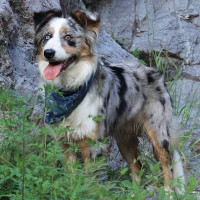Appearance of the Border-Aussie
|
| Border-Aussies are already fairly uniform in appearance, even though they haven't been around very long. This is obviously because their parents are closely related and share many physical characteristics. Australian Shepherds are moderately taller and heavier than Border Collies, so it's not surprising that Border-Aussies generally fall somewhere in between. On average, they measure between 48 and 56 cm and weigh between 25 and 28 kg, making them a good medium-sized breed. Border-Aussies are medium-sized dogs with strong muscles and a well-proportioned structure. They have a medium-sized skull with a good-sized muzzle. Their ears are semi-erect on the side of the head and prick up when the dog is interested in something. Their eyes are bright and sharp, giving us an indication of their intellect. They can have light blue or brown eyes, and there's a current trend towards heterochromia, having one eye of each color. The Border-Aussie's coat is a double layer, and its thickness and length vary from dog to dog. There are many potential color combinations, including the Border Collie's traditional black and white, as well as merle, red, white and the sought-after tricolor blue, among many others. |
Temperament of the Border-Aussie
|
| The most prized characteristics of Border-Aussies are their impressive intellectual capacity and the speed with which they can grasp a range of new tricks and tasks. They are extremely docile and always eager to please their humans. They are known to be able to learn a large number of clues. This is a double-edged sword because, while it may make it possible to have a highly trained working dog, it means these guys need almost constant stimulation to stay balanced and content. The Border-Aussie's biggest drawback is that, in the wrong hands, they can turn into very disturbed pets. A lack of exercise and/or mental stimulation can lead to tail chasing, tail biting, incessant barking, digging and other negative vices. Border-Aussies are not the most cuddly dogs, but will have a loving relationship with their own family. When it comes to new people, they are generally aloof. Introducing them to children at an early age should ensure their tolerance, however, they tend to want to control and keep children in groups as soon as they start walking. This is not the breed for those who live in urban areas in small houses. They need lots of outdoor space and freedom. On top of that, they need to be surrounded by people and don't do well when left alone for too long. |
Needs and activities of the Border-Aussie
|
| Border Collies and Australian Shepherds are very athletic and energetic animals, and require a lot of exercise. Although the mix isn't as intense as the purebred Border Collie, they're generally happiest and healthiest when they get at least two hours of vigorous physical activity and mental stimulation a day. In addition to brisk walks or jogging, this dog may also be able to expend its considerable energy with alternative activities, such as freestyle dancing, competitive Frisbee, agility training and herding. Although they are fairly quiet, this crossbreed is generally not suitable for apartment living, as it has such high energy levels. |
Maintenance of the Border-Aussie
|
| Border-Aussies require regular grooming, but on the whole they're pretty easy to look after. These dogs generally have a relatively low odor, although a bath every month or two keeps them stink-free and can help reduce constant shedding. Their abundant, medium-length fur is prone to matting and matting if left unattended, and brushing is necessary several times a week, although daily is best. It's especially important to keep this breed's ears clean, as the hair growing in them can trap dirt and other contaminants, increasing the risk of your dog developing an ear infection. |









 English (United Kingdom)
English (United Kingdom)